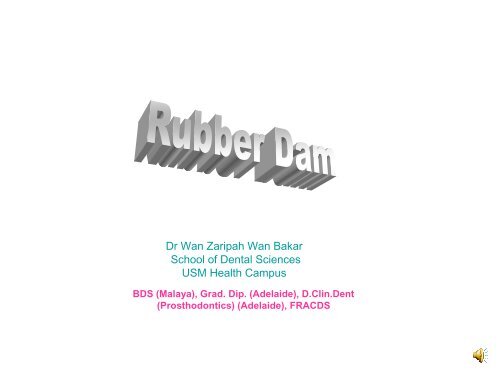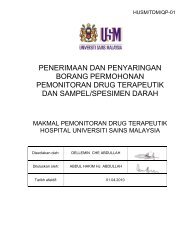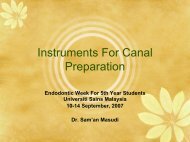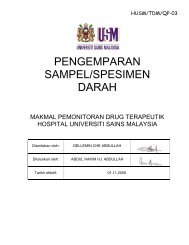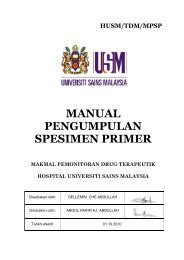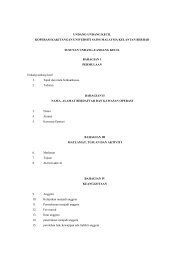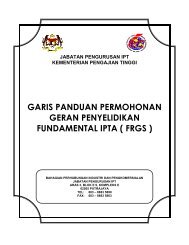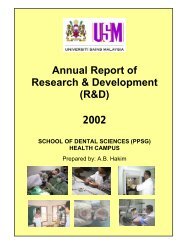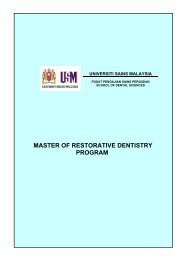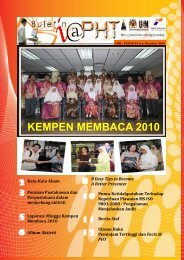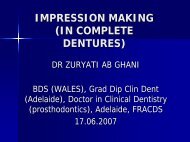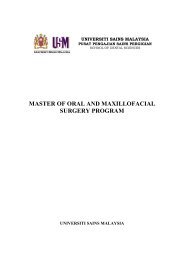Dr Wan Zaripah Wan Bakar School of Dental Sciences USM Health ...
Dr Wan Zaripah Wan Bakar School of Dental Sciences USM Health ...
Dr Wan Zaripah Wan Bakar School of Dental Sciences USM Health ...
Create successful ePaper yourself
Turn your PDF publications into a flip-book with our unique Google optimized e-Paper software.
<strong>Dr</strong> <strong>Wan</strong> <strong>Zaripah</strong> <strong>Wan</strong> <strong>Bakar</strong><br />
<strong>School</strong> <strong>of</strong> <strong>Dental</strong> <strong>Sciences</strong><br />
<strong>USM</strong> <strong>Health</strong> Campus<br />
BDS (Malaya), Grad. Dip. (Adelaide), D.Clin.Dent<br />
(Prosthodontics) (Adelaide), FRACDS
Outline <strong>of</strong> Lecture<br />
• What is Rubber Dam<br />
• Functions<br />
• Armamentariums<br />
• Steps <strong>of</strong> Application<br />
• Techniques
What is Rubber Dam (RD)?<br />
• The rubber dam is a flat thin sheet <strong>of</strong> latex/ non-latex that is held by<br />
a clamp and frame that is perforated to allow the teeth that will be<br />
worked on to protrude through the perforations in the sheet while all<br />
the other teeth are covered and protected by the rubber dam.<br />
• Moisture control<br />
• Infection control
The Benefits<br />
• Raincoat for your teeth<br />
• Limits bacterial laden splash and splatter <strong>of</strong> saliva and blood.<br />
• Restricts drowning response during rinsing the mouth in a procedure.<br />
• Serves as a barrier, so your throat is protected from debris and tiny<br />
instruments from being swallowed or inhaled.<br />
• Isolates and protects the area that needs to be worked on.<br />
Improves accessibility and visibility <strong>of</strong> the working area.<br />
Infection control.<br />
Helps to protect your gag reflex area from being triggered.<br />
protects the lips and cheeks by keeping them out <strong>of</strong> the way.<br />
Helps to keep your tongue out <strong>of</strong> the way <strong>of</strong> the work area so it is<br />
not harmed.
• Give a dry clean environment for tooth colored fillings to be successful. The<br />
moist air exhaled from your mouth can increase the humidity in the working<br />
area causing weaker bonds leading to weaker fillings.<br />
• Keeps teeth saliva free while performing a root canal so the tooth does not<br />
get re-contaminated by the bacteria that is in saliva.<br />
• Don't have to concentrate on staying open or positioning your tongue out <strong>of</strong><br />
the work area.<br />
• Gives you peace <strong>of</strong> mind that objects will not fall into your throat.<br />
Mandatory for endodontic treatments and deep caries lesions management
Contraindications<br />
• If a tooth is too short to hold a clamp<br />
• Tooth not fully erupted<br />
• Not enough area to clamp tooth<br />
• Patient's inability to handle their own oral secretions, e.g., a person<br />
with Parkinson's disease (may have a diminished ability to swallow<br />
and therefore be unable to handle saliva accumulation under the<br />
rub)
Armamentarium<br />
Instruments needed:<br />
Topical LA or infiltration (optional<br />
in patient)<br />
Rubber dam<br />
Punch hole<br />
Clamps<br />
Clamp holder<br />
Floss<br />
Rubber dam frame<br />
Napkin (in patient)<br />
Vaseline<br />
Scissors<br />
Triple syringe<br />
Probe 6<br />
Rubber Dam<br />
Latex<br />
Non-latex<br />
Extra stretchable<br />
Punch hole and Clamp holder<br />
RD punch: eg. Aesculap DF 401; 1-5 holes size<br />
Punch the hole following the tooth size
Clamps<br />
Posterior<br />
Anterior-”butterfly”<br />
Types<br />
Winged<br />
Unwinged<br />
Winged clamps provide more retraction <strong>of</strong><br />
tongue, cheeks, lips.<br />
-Record the clamp no. and RD method for<br />
future references.
• Rubber dam frame<br />
- flipable frame<br />
- place under the RD preferable<br />
• Napkin<br />
- avoids skin irritation, more comfort<br />
• Vaseline<br />
• Floss<br />
• Oraseal (Ultradent)<br />
- to seal the dam margin
Application steps<br />
Steps:<br />
• i) Position the rubber dam (RD) on the teeth area and marks the holes point.<br />
• ii) Punch the correct hole size for the suitability <strong>of</strong> tooth size with the punch hole.<br />
• iii) Apply vaseline on the inside surface <strong>of</strong> the hole on the RD.<br />
-if tooth broken down – restore @ temporarise first @ use Cuff technique.<br />
• iv) Choose the correct clamp and tie with the floss.<br />
v) Apply topical or infiltration (in patients)<br />
vi) Position the RD and clamps using one <strong>of</strong> the 3 techniques.<br />
vii) Check the stability <strong>of</strong> clamps<br />
viii)Position the napkin (in patient) and later apply the frame properly.<br />
Technique I : insert clamp first<br />
Technique 2 : Insert rubber dam first<br />
Technique 3 : insert together; both fixed outside first<br />
ix) Confirm the correct flip <strong>of</strong> the RD at teeth area using triple syringe and probe 6 for<br />
proper isolation<br />
x) Excess RD can be trimmed with scissors and tie the floss proper<br />
xi) Check the symmetrical and uncovered the nose area.
• Single<br />
• Multiple<br />
• “Cuff Technique”<br />
Rubber Dam Techniques<br />
“Cuff Technique”<br />
Indications:<br />
- a very broken tooth<br />
- more than one tooth need isolation<br />
- avoidance <strong>of</strong> crown margin from chipping by the clamp<br />
- bridge work<br />
- treatment for subgingival or gum level area
References<br />
• Endodontics and dental traumatology- An overview <strong>of</strong> modern endodontics.<br />
Paul V. Abbott<br />
• http://www.dentalgentlecare.com/rubber_dam.htm.<br />
• Worksheet on rubber Dam placements manual


